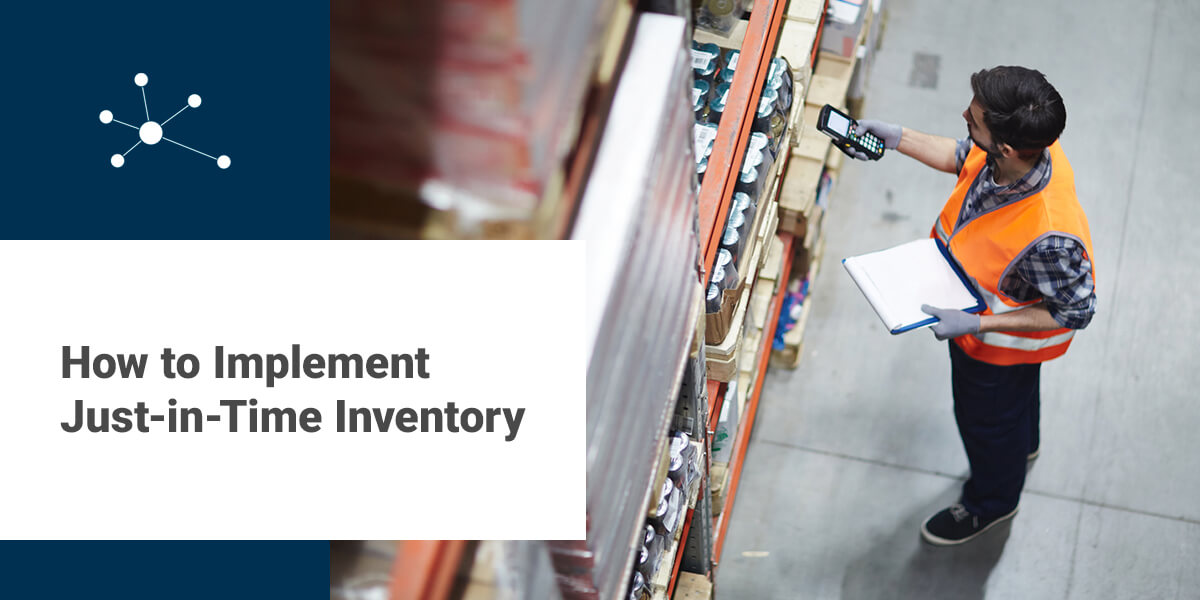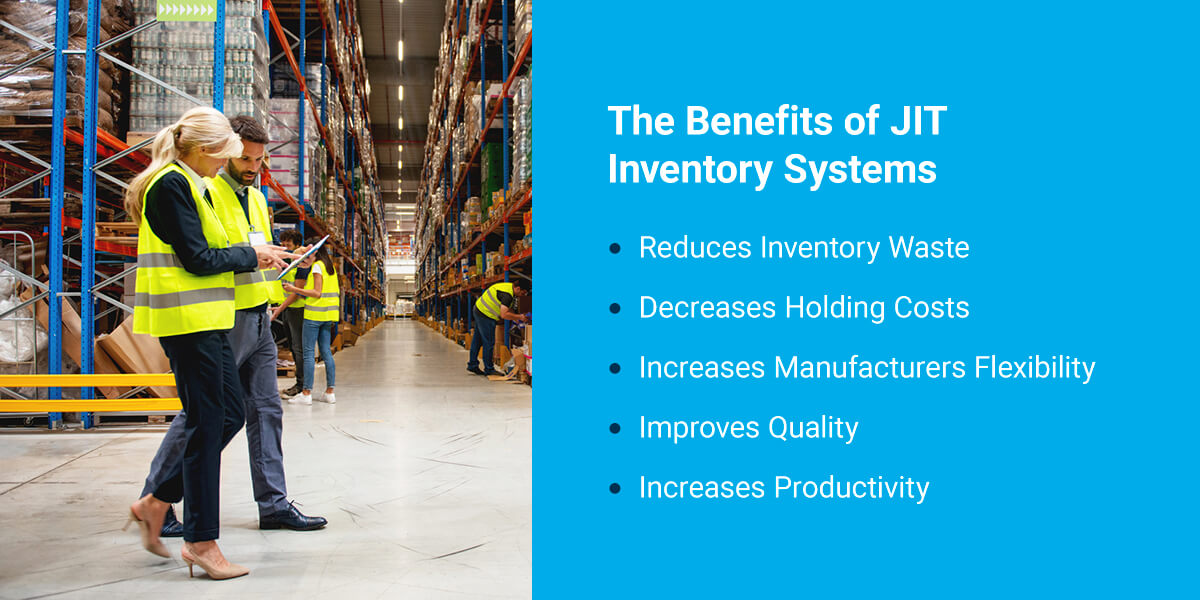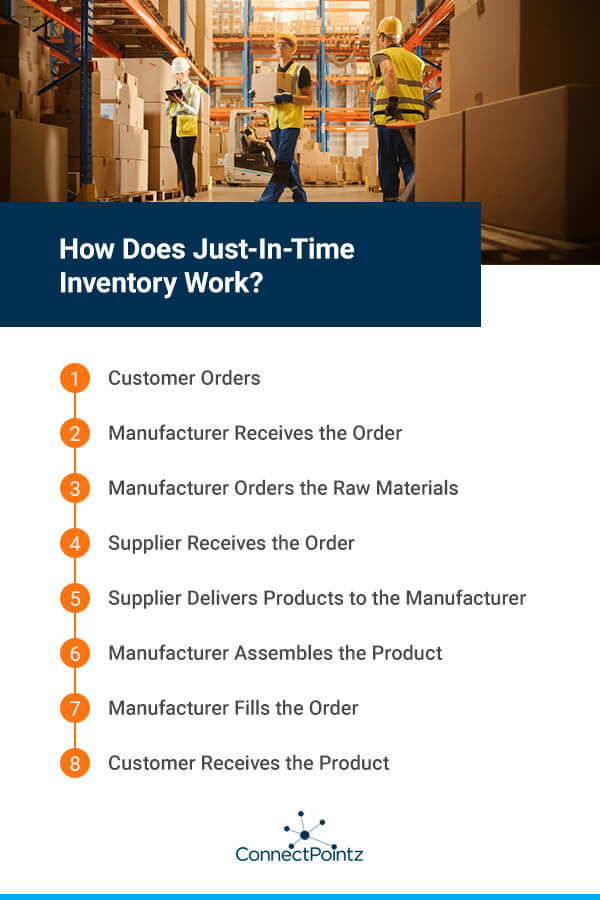
By implementing just-in-time (JIT) inventory solutions for your business, you can gain a wide range of advantages. As a proven solution for optimizing your inventory system, JIT management allows you to source production materials seamlessly and deliver final output to clients efficiently. With the right plan in place, you can more effectively meet consumer demand long term and stay ahead of production needs.
The JIT inventory system can work for you by matching your operational requirements and helping maximize the efficiency of your supply chain. Read on to explore how the system operates, the advantages and disadvantages you should consider, and how to implement it to meet your business's unique needs.
What Is Just-In-Time Inventory?
JIT inventory systems work by forecasting requirements and supplying the necessary resources on a scheduled basis for each production cycle. As a type of inventory management that coordinates your raw materials, the system helps ensure you receive supplies right on schedule to coincide with when your production of goods begins. Using the JIT inventory method can help decrease waste by supplying products only when needed for the next manufacturing phase.
The founder of Toyota originally established the JIT concept to meet production needs at vehicle manufacturing facilities in Japan. Former Toyota Executive Vice President Taiichi Ono developed the JIT solution after extensive testing in the 1940s and 1950s to address the need of receiving the right automotive parts at the correct time to advance production. Over time, as the program continued to advance, industries worldwide began to adopt it to minimize waste and maximize efficiency at the work site.
Ensuring you have the materials you need right on time and no sooner can assist with keeping production running smoothly and efficiently. Ultimately, time inventory solutions can help you more effectively meet consumer demand and deliver final products to your clients. By maintaining a tight schedule for supply deliveries and aligning them strategically with your production stages, you can accomplish more efficient fabrication with less inventory on hand at any given time.
The Benefits of JIT Inventory Systems

When you work with a JIT inventory system, you can optimize your manufacturing processes in multiple ways. Proper implementation of the solution offers advantages for your production workflow while helping improve overall efficiency across manufacturing stages. Explore how the system can match your requirements.
Reduces Inventory Waste
This solution ensures the goods you receive at your facility are exclusively needed for immediate production. That way, you will not have excess raw materials or additional storage requirements, helping you minimize inventory waste across stages of operation.
With the careful planning required to manage each production cycle's requirements, you can ensure you have just the right amount of inventory to meet your specific operational needs. Accurate demand projections and analysis of resource requirements are critical to the effective implementation of JIT.
Decreases Holding Costs
With JIT inventory management, you can reduce overall holding costs by implementing more efficient material use. Ensuring raw materials arrive directly when needed for production allows you to decrease storage requirements across your facility.
Naturally, with less inventory on hand that you need to keep in secure storage, you can cut down on potentially high holding costs in separate facilities. At the same time, you free up more facility space for day-to-day operations and production capacity.
Increases Manufacturers Flexibility
When you coordinate material deliveries on demand to match your operational processes, you get increased flexibility for day-to-day applications. Scaling to current demand and production needs is easier and more resource-efficient. When the market for your product slows or increases, you have the flexibility to adjust your inventory to your operations, helping cut down on waste and avoid overspending on materials.
Improves Quality
Your facility can optimize production quality with freshly sourced materials to keep operations running. Using your raw resources immediately can also cut down on the risk of damage while in storage. You'll be able to get the most value from raw materials while maximizing overall productivity. With the proper ratio of supplies for each production cycle, you can avoid the risk of cutting corners or missing a critical element necessary for high-quality manufacturing.
Increases Productivity
The JIT system is proven to optimize operational efficiency, as you get the most value from your operating resources. When you immediately have the materials on hand to manage the entire product lifecycle, you can help streamline your team's day-to-day operations and improve productivity across your company.
The Drawbacks of JIT Inventory Systems
Along with the advantages JIT offers, the system can also bring some potential challenges. You'll need to consider how to address these obstacles and evaluate whether your facility is prepared to navigate them effectively. Having the right strategy to manage potential drawbacks is critical to getting optimal value from the JIT solution.
Before you choose to implement JIT management, you will want to consider key drawbacks to the system.
Requires Dependable Vendors
Setting up a time inventory system requires highly reliable vendors. You need to be sure that materials will arrive as scheduled to keep your operations running and avoid any potential downtime. If a vendor is not consistent with meeting delivery times or other criteria, you may need to make changes to ensure JIT can work for your operations.
Relies Heavily on Accurate Forecasting
As you plan for inventory deliveries, having accurate forecasting is integral to successful scheduling and turnaround. The process heavily depends on the reliability of demand and projections for required inventory amounts and types.
You'll need to analyze current trends, consistently evaluate changes or indicators of future demand, and reliably forecast upcoming consumer orders. To effectively supply your production with enough materials, navigating this potential obstacle is integral to the system's overall success.
Requires Changing Processes and Procedures
To implement JIT management, you'll need to adjust various workflows. You must have a strategy for transitioning to this new processing method and incorporate the correct production schedules to align with material deliveries. Keep in mind that how production is scheduled and managed day-to-day will look different, and you will need to provide the appropriate resources and training for employees on the job site.
Company Must Be on Board With the Changes
You can expect many aspects of your business procedures to look different with JIT implementation, so you'll need to ensure your company can support the adjustments. Adjusting protocol, scheduling and workflows will require other members' approval and cooperation.
You'll need to consult with key stakeholders and navigate any concerns or additional considerations that may present themselves. Ensure you're prepared to navigate potential objections and provide reliable data to demonstrate the system's value.
Local Sourcing Costs Can Affect Profitability
As you manage local sourcing expenses to keep operations running, the costs can impact the company's overall revenue flow. Additional charges to ensure on-time deliveries from local sources can increase material expenses at various points during production. You'll want to evaluate the projected costs of JIT material deliveries and understand how it may affect your business's profitability long term.
How Does Just-In-Time Inventory Work?

Once you've considered the advantages and risks of just-in-time inventory solutions, ensure you have the resources and tools you need to move forward. If the system fits your requirements and you can address any potential drawbacks, you can begin moving toward implementation. You can expect this process to follow consistent steps for each production cycle.
1. Customer Orders
The first step in the inventory and order fulfillment process is when a customer puts in an order. They'll identify a product need, interact with the company's market interface and order the product from the business. From there, the manufacturer will need to manage turnaround to meet demand as efficiently as possible.
2. Manufacturer Receives the Order
After your company sends the order in, the manufacturer will receive and process it. Accurately recording orders and ensuring they move efficiently to production is essential for this step.
3. Manufacturer Orders the Raw Materials
To fulfill a consumer's purchase, the manufacturer will order raw materials in real-time preparation for production. Agreeing on a set schedule with the suppliers is vital, as the material deliveries and planned production cycle must align strategically to complete the final product.
4. Supplier Receives the Order
The supplier will then receive the order and source the necessary raw materials. They need to meet the schedule required by the manufacturer to complete production, delivering materials just in time for the beginning of the manufacturing process.
5. Supplier Delivers Products to the Manufacturer
Based on time constraints and sourcing requirements, the supplier will then deliver the product to the manufacturer. As it arrives, it should line up with the start of production, supplying the necessary inventory while minimizing waste in the process.
6. Manufacturer Assembles the Product
Once the manufacturer receives the required materials, the facility can start production. With sufficient resources available, manufacturing can begin on schedule. They'll manage assembly, quality controls and any other steps in the workflow before the final output is complete.
7. Manufacturer Fills the Order
With the final product complete, the manufacturer prepares the order for delivery to the customer. The business will fulfill the order and send out the required product to reach the consumer on schedule.
8. Customer Receives the Product
The final stage of the just-in-time system is when the consumer receives their completed order. Upon arrival, the product has completed the manufacturing and order fulfillment cycle through just-in-time management.
Who Uses JIT Management?

The JIT system can meet a wide range of standard applications in business sectors. ConnectPointz works with clients across several industry verticals to handle just-in-time inventory needs. As our case studies demonstrate, this system can be a powerful answer to demands for increased cost-efficiency, decreased material waste and optimized productivity in facilities. JIT fits various workflows and requirements for different markets.
Food and Beverage
The JIT management system can handle various product fulfillment requirements for manufacturers in the food and beverage industry. Delivering fresh foods and beverages on time is vital to building a business reputation and increasing consumer loyalty. This industry can use JIT to streamline production, enhance food quality and provide efficient turnaround for clients.
Food is prepared only when a customer puts in an order, so JIT can help optimize the made-to-order process. It offers a solution for minimizing waste and providing fresh ingredients for meals and beverages. These procedures can help businesses get a market advantage while delivering an efficient turnaround on client orders.
Home and Garden
In various home and garden markets, such as florist businesses, products are also made-to-order based on client preferences. Customers want specific designs and products that meet quality standards for their applications. With JIT solutions, home and garden industries can manage consumer demand and plan for particular items and inventory amounts to purchase.
This solution equips businesses to schedule material deliveries in advance and ensure high-demand or hard-to-access garden items are available just in time for order fulfillment. Many of these products have time-sensitive lifespans or specific storage requirements, so this delivery solution can simplify management while decreasing product waste.
Retail
In the retail manufacturing industry, managing fluctuating consumer demand is vital to stay ahead. With JIT solutions, businesses can maintain better control over the entire manufacturing process. With the ability to get smaller inventory deliveries at a time, companies can scale to unique requirements for current market conditions.
This system helps to reduce inventory storage requirements, freeing up more floor space for production and management operations in facilities. Additionally, it can cut down on resource waste and improve overall productivity across the company. A smooth workflow focused on efficient material use allows for high-quality product output that is consistent and timely, cooperating with current market requirements.
Technology
A wide range of technologies markets can rely on JIT for streamlined operations. This solution helps mitigate the struggles of storing materials until production, saving valuable space at operating facilities. The system can also help companies be more competitive while delivering efficient service and preventing waste of resources.
As technology demand evolves, the JIT system can help the industry stay ahead of the market. With accurate forecasting and strategic, on-demand ordering, businesses have more flexibility to scale to consumer needs.
Learn How ConnectPointz Can Optimize Your Inventory Management
Adopting the just-in-time inventory approach offers a range of benefits for your industry. By helping reduce waste, maximize productivity and increase cost-efficiency, this solution can streamline your inventory management and improve overall revenue. JIT can work with your unique operational requirements to help you get the most value during material sourcing and production.
At ConnectPoint, we offer trusted solutions and the most affordable, consistent pricing to fit your budget and applications. Delivering end-to-end automation services to streamline your entire production process, we bring over 35 years of industry expertise to address your business needs. We stand out for our flexibility to customize based on your operation-specific requirements, and we prioritize delivering the best value solutions for you.
Let us help simplify new merchant onboarding, reduce high operational costs and increase transparency across your business process. If you're interested in learning more about what we have to offer, contact ConnectPointz to learn how we can help manage inventory with EDI solutions.










































